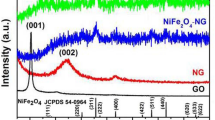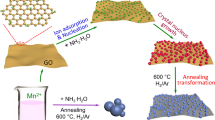Abstract
Graphene is an excellent substrate to load nanomaterials for energy applications due to its large surface area, excellent conductivity, mechanical strength, and chemical stability. In this study, thermal exfoliated functionalized graphene sheets with good conductivity and high BET surface area are anchored with mesoporous NiO nanoplates by in situ chemical synthesis approach. Electrochemical characterization shows that functionalized graphene sheets–NiO sample exhibits a high capacity of about 700 mAh/g at a discharge current density of 100 mA/g and a good cycling ability. The high capacity and good cycling ability of functionalized graphene sheets –NiO material were attributed to the intimate interaction between the graphene sheets and NiO nanoplates. The graphene sheets not only enhance the conductivity of NiO nanoplates but also improve the structure stability of NiO nanoplates. Furthermore, the mesoporous structure of NiO nanoplates is available to the transfer of electrolyte. Such functionalized graphene sheets–NiO nanocomposite could be a promising candidate material for a high-capacity, low cost, and nontoxic anode for lithium-ion batteries.




Similar content being viewed by others
Abbreviations
- FGS:
-
Functionalized graphene sheets
Reference
Armand M, Tarascon JM (2008) Nature 451:652–657
Ellis BL, Lee KT, Nazar LF (2010) Chem Mater 22:691–714
Scrosati B, Garche J (2010) J Power Sources 195:2419–2430
Li WY, Xu LN, Chen J (2005) Adv Funct Mater 15:851–857
Meduri P, Pendyala C, Kumar V, Sumanasekera GU, Sunkara MK (2009) Nano Lett 9:612–616
Wu CZ, Yin P, Zhu X, Yang CZO, Xie Y (2006) J Phys Chem B 110:17806–17812
Varghese B, Reddy MV, Wu ZY, Lit CS, Rao HTC, Chowdari BV, Wee ATS, Lim CT, Sow CH (2008) Chem Mater 20:3360–3367
Boukamp BA, Lesh GC, Huggins RA (1981) J Electrochem Soc 128:725–730
Wang HL, Casalongue HS, Liang YY, Dai HJ (2010) J Am Chem Soc 132:7472–7477
Du QL, Zheng MB, Zhang LF, Wang YW, Chen JH, Xue LP, Dai WJ, Ji GB, Cao JM (2010) Electrochim Acta 55:3897–3903
Hummers WS, Offeman RE (1958) J Am Chem Soc 80:1339–1339
Liu PG, Gong KC, Xiao P, Xiao M (2000) J Mater Chem 10:933–935
Howatt G, Breckenridge R, Brownlow J (1947) J Am Ceram Soc 30:237–242
Huang XH, Tu JP, Zhang CQ, Zhou F (2010) Electrochim Acta 16:8981–8985
Derrien G, Hassoun J, Panero S, Scrosati B (2007) Adv Mater 19:2336–2340
Ban CM, Wu ZC, Gillaspie DT, Chen L, Yan YF, Blackburn JL, Dillon AC (2010) Adv Mater 22:E145–E149
Guo P, Song HH, Chen XH (2009) Electrochem Commun 11:1320–1324
Rahman MM, Chou SL, Zhong C, Wang JZ, Wexler D, Liu HK (2010) Solid State Ionics 180:1646–1651
Zhou GM, Wang DW, Li F, Zhang LL, Li N, Wu ZS, Wen L, Lu GQ, Cheng HM (2010) Chem Mater 22:5306–5313
Acknowledgments
This work was supported by China Postdoctoral Science Foundation (No. 20100471296), Postdoctoral Foundation of Jiangsu Province (No. 1001003C), Nature Science Foundation of Jiangsu Province (No. BK2007146), and National Nature Science Foundation of China (No. 60928009 and 60990314).
Author information
Authors and Affiliations
Corresponding author
Additional information
Danfeng Qiu and Zijing Xu contributed equally to this work.
Rights and permissions
About this article
Cite this article
Qiu, D., Xu, Z., Zheng, M. et al. Graphene anchored with mesoporous NiO nanoplates as anode material for lithium-ion batteries. J Solid State Electrochem 16, 1889–1892 (2012). https://doi.org/10.1007/s10008-011-1466-9
Received:
Revised:
Accepted:
Published:
Issue Date:
DOI: https://doi.org/10.1007/s10008-011-1466-9




